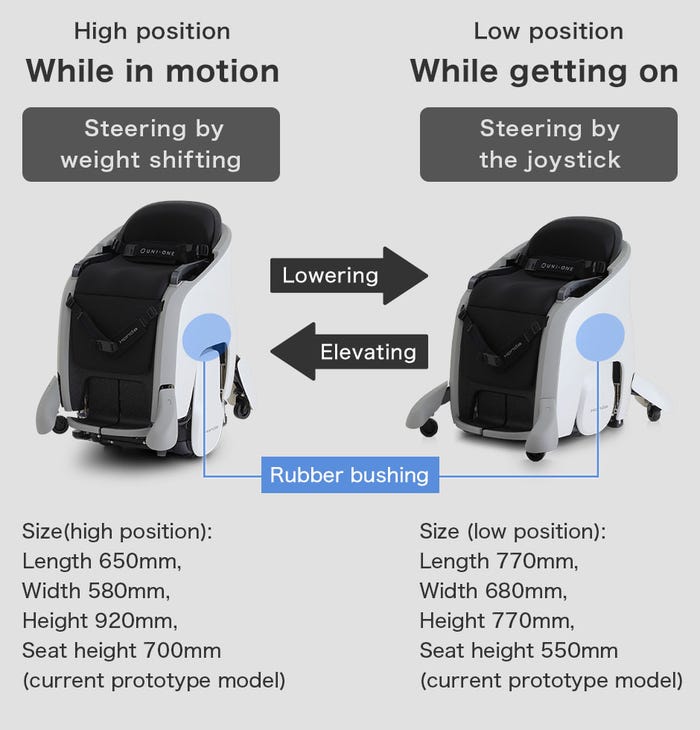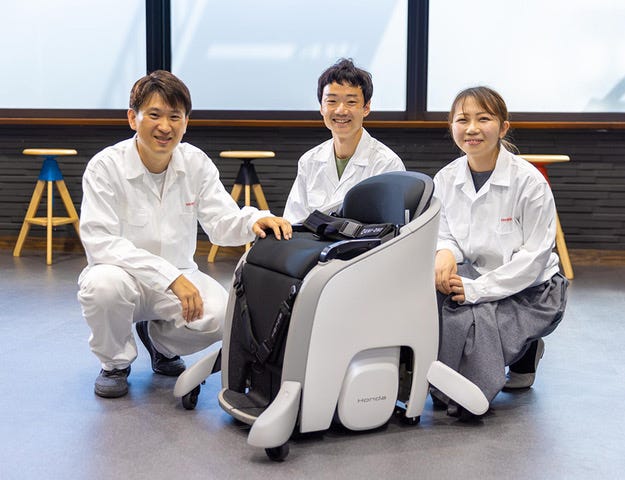Honda Takes Personal Mobility to a New Dimension
The new UNI-ONE device advances technology the company first showcased in 2013. It’s Extended Reality Mobility Experience is live now at SXSW 2024.
March 14, 2024

When it comes to personal mobility, Honda aims to combine virtual reality with its extensive engineering expertise to create “an all-new entertainment experience” for users. The company is showcasing this effort at the current SXSW 2024 festival in Austin, TX.
At the core of this is the Honda UNI-ONE, a sleek, hands-free, personal mobility device (don’t call it a wheelchair, the firm insists). It features advanced, self-balancing technology and sensors that enable users to move in any direction by shifting their center of gravity. Conceptually, it’s akin to a seated Segway.
“The goal of Honda Robotics is to help people in their daily lives, and one of the key concepts of Honda Robotics is the ‘expansion of the physical functions for people,’ " the company states. "Based on this concept, we are developing the UNI-ONE, a hands-free personal mobility device that offers new value to our customers by enabling them to enjoy mobility without being constrained by their physical capabilities and/or skills.”
Two Seating Levels
Users can raise or lower the seat on the electric UNI-ONE. In the “high position mode” (reaching 27.6 inches), one is closer to the eye level of someone standing and can move in all directions––forward, backward, sideways, or diagonally. One also can turn around with both hands free, simply by leaning in one direction to shift their weight. (See video below.)
UNI-ONE will be in “low position mode” while the user is getting on. In this mode (21.7 in.), the seat allows the user to communicate better with those who are seated or with small children and can move in any direction by steering with a joystick.
When switching between these two modes, the UNI-ONE initially faced some issues, Honda acknowledges. These included making unexpectedly large movements caused by an uneven ground surface and/or a slight deviation of the user’s posture. As a result, the user felt the impact of the landing (when the UNI-ONE takes the low position) which was transmitted through the seat.

Honda brought its engineering expertise to bear on this new model. HONDA
Rubber Bushing Softens the Blow
To address this, the firm embedded a soft rubber bushing between the parts that go up and down when switching modes (the seat and the landing leg) and the wheel mechanism unit. Then the stabilization controller applied optimal balance control while taking into consideration the characteristics of the rubber bushing, realizing smooth mode changes.
Moreover, Honda adds, the mode change is normally done electrically by pressing the up/down button. But in the event of an error, the system promptly and mechanically puts the UNI-ONE in the low position as soon as the error is detected, thereby preventing the tipping over of the UNI-ONE as much as possible.

Honda is combining virtual reality with the UNI-ONE to create what it calls “a first-of-its-kind extended reality experience.” Attendees at this week’s SXSW can try it out for themselves. HONDA
A Case of Continual Evolution for Mobility
The UNI-ONE is the result of product evolution. Honda equipped its new device with the latest version of the company’s original wheel mechanism, called the Honda Omni Traction Drive System (HOT Drive System). This technology first appeared in 2013 on the UNI-CUB β that Honda described “as a personal mobility device people can use in their everyday lives.”
The 154-pound UNI-ONE prototype uses a pair of improved HOT Drive Systems––one on each side––which enables the user to move smoothly in any direction. Honda calls it a "human-machine cooperative balance control technology."
UNI-ONE can reach a maximum speed of 3.7 miles per hour, and its replaceable lithium ion battery has a 5-mile range (at 2.5 mph). Its maximum user weight is 242 pounds.
The company explains that the system uses posture sensors to detect the user’s natural postural movements, similar to what happens when a person walks. “By using data such as inclination angle and angular velocity, the intension estimation controller performs calculations to estimate the user’s intentions, such as whether the user wants to stay in place, or to move toward which direction and at what speed,” it explains.
Based on the results of that estimate, the stabilization controller performs calculations to control the wheels so that the UNI-ONE does not lean too far and applies feedback control to achieve natural behavior that is neither too fast nor too slow.

Three key members of the UNI-ONE development team, from left to right: Masaki Goto (who oversaw the electrical equipment), Daisuke Nohara (the vehicle body), and Marika Mochizuki (product design). HONDA
Designing for Optimal Control & Stability
Through continuing efforts, Honda has increased calculation speed to be more than twice as fast as that of the UNI-CUB β it developed a decade ago. As a result, by applying feedback control at that faster speed, the UNI-ONE enables the user to move as intended by making slight changes in their posture.
The company says the device can move around easily while offering a high degree of operational stability. This, it notes, makes it easy to ride for all kinds of people, including elderly and children. It is continuing to develop UNI-ONE to accommodate people with a disability in the lower limbs who have ability to maintain their balance while sitting.
“We researched tip-over prevention methods for a variety of situations, including during outdoor use," Honda says. "When determining seat height, we carried out extensive examination, talking to actual wheelchair users and caregivers. For a mobility device we envisaged would be used in crowded spaces, we devised, developed, and refined a people-friendly curved design that achieved balance between the contradicting requirements of compactness and stability.”
(See video interviews with three of the Honda engineers on the UNI-ONE development team.)
‘Extended Reality’ Entertainment
At the March 8-16 SWSX, Honda is doing the global roll-out of what it calls “a first-of-its-kind extended reality experience ... merging the joy of mobility with virtual reality adventures.” (It uses the term XR (extended reality) as an umbrella term for technologies such as VR (virtual reality), AR (augmented reality), and MR (mixed reality) “that fuse the real world with the virtual world to enable the perception of things that do not exist in reality.”)
Attendees to the event can ride UNI-ONE and immerse themselves in their own “choose your VR adventure” at the Honda XR Mobility Experience (catch a glimpse here). “While wearing a VR headset and shifting their body weight to steer UNI-ONE,” Honda says, “users can experience the peaceful feeling of floating in the sky or the exhilarating feeling of gliding along a half-pipe path.”
The company says it is working toward commercializing the device in the U.S. It says it envisions people enjoying the XR mobility experience in indoor and outdoor obstacle-free spaces, including theme parks, entertainment facilities, and retail spaces such as shopping malls. Honda also believes that UNI-ONE can be used as a mobility device in XR games, such as a racing game where players use their hands while moving freely or a game in which players follow certain routes.
Since this is a prototype, Honda says it vacuum cast the components from a polyurethane resin, selected to be a grade equivalent to polypropylene. In an email interview, the firm said, “The mechanical properties can be considered to be almost the same as PP. Tensile strength is 30-40MPa. Bending strength is 40-50MPa. Heat-resistant temperature: is120-130℃, and its hardness is (Rockwell) R80-100.”
In addition to entertainment and retail business partners, Honda says it is seeking to collaborate with AR and VR developers to create custom digital experiences choreographed with the movements of riding UNI-ONE. Interested companies can visit Honda’s booth #729 at the SXSW Creative Industries Expo or contact [email protected].
About the Author(s)
You May Also Like




